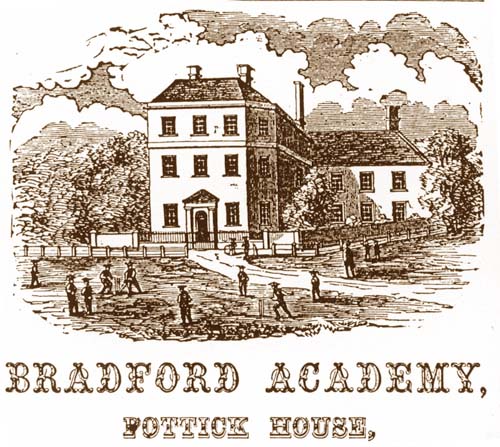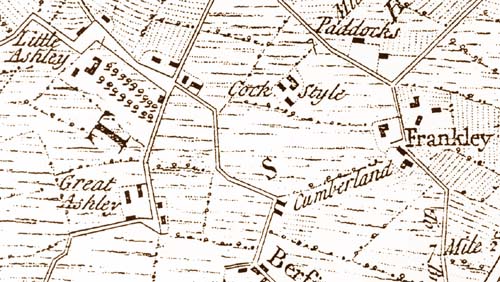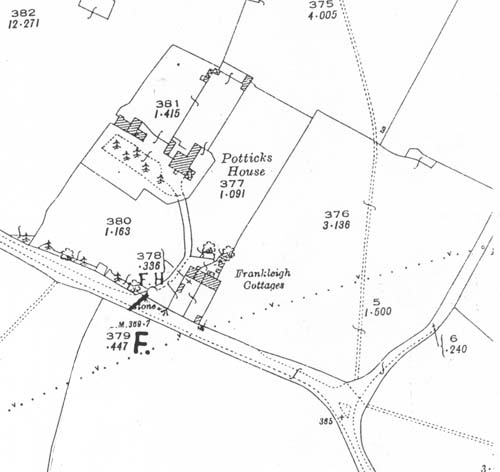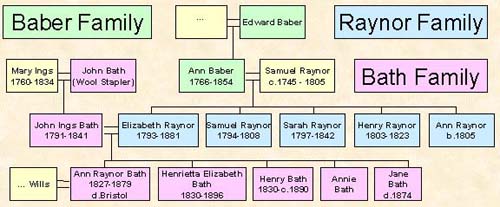Pottick
House - home of the Rayners

The
house as we see it now faces south west and consists of a main range of three
storeys, with two short wings at the rear, the eastern one having a long two storey
range extending to the north eest. The front range was apparently built in the
Georgian period and the architecture suggests a date after 1780. The 1841 Tithe
Apportionment map(1) shows that by that time the house had acquired the two short
wings at the rear. They have lean-to roofs, the space between them has now been
filled in. The cornice at the top of the front elevation of the ho11se and the
plat hand running across the face jus~ below the first floor windows are both
carried on round the sides and on to the rear of the front range(7)
this indicates that these two wings were built after the main range. The
straight joints in the stonework where thl~ wings abut against. the front range
give further support for this dating. Later still came the longer building which
now extends the eastern wing, added perhaps for the school which occupied the
house from the 1850 to 1870. There was no building in that position in 1841. The
fact that this extension is more recent than the wing to which j.t is attached
is shown by the position of the quoins next to the 'straight joint in the stonework
between the wing and the extension. These quoins are on the wing Bide o'f the
joint, on the earlier part of the building. The joint, too. is aligned with the
exterior of the north wall of the wing, agagin showing the wing came first -one
cannot nave a detached extension here with no south end wall.
The name Potticks
occurs in various forms in the archives, referring to the house or its surroundings.
Pot ticks House was so calleed in the 1851 census(2), but is not named in that
of 1841, perhaps because it may have been unoccupied then. At that time however,
two pastures nearby were called Pothookes.
In 1805 an entry in the South
Wraxall parish registers(3) records the death of Mr.Samuel Raynor of Pothokes.
Clearly at least part of the house must have been built by that time. Again, when
Mr.William Miles married Margaret Reynolds in 1779(4), he endowed her, among other
property, with 'two pieces of pasture called Puddocks...near Thrankley otherwise
Frankley'. The wording of this shows that there was then no building on Puddocks.
A similar variant of the name is on ,the 1743 map(5) entitled "Five Miles Round
Bath", where the Old Quaker House is marked Paddocks. Potticks does not appear
on Andrews & Dury's map of 1773; only the Quakers Meeting House is there(6).
There are also a couple of references to personal names which may be related to
Pot ticks. The book 'The Place Names of Wiltshire'(7) suggests a connexion with
a Ralph Poteck, mentioned in a Lay Subsidy Roll in 1523. He must have been a prosperous
man to appear in the Subsidy list, and may have had land around Pot ticks -but
there is no evidence for or , against that. Finally, in the Shaftesbury Abbey
accounts for Brad ford in 1372(8) when Joan Formage was Abbess, we read of John
Puttock paying 2s. rent for two shops newly erected in Bradford, probably near
the market place.
Potticks -the History
More is known about Samuel
Raynor than about most of the earlier residents at Pot ticks House. For this reason
and also because a descendant of his was still living there in 19399, this history
begins with his life. He was born around 1745, probably not in Bradford, but evidently
played quite a prominent part in the life of the town in his lateryears. Between
1775 and 1788 his name is often found among those signing the minutes of the parish
vestry meetings(10), particularly in connexion with the care for the poor. A visit
from John Wesley in March 1784 shows a wider aspect of his friendships. Wesley
wrote in his Diary(11) "Friday 12th, being at Samuel Raynor's in Bradford (town),
I was convinced of two vulgar errors; the one, that nightingales will not live
in cages; the other, that they only sing a month or two in the year. He has now
three nightingales in cages, and they sing almost all day long, from November
to August".
Then in 1788, the parish accounts(12), on the expenditure
side record "By Mr.Raynor for a carper to cover the floor of the communion Table
£1.9s.-.
From that year, too, there survives a Copy of Court Roll of the Bradford
Prebendal Manor13, recording "the surrender by Thomas Bush of Bradford, clothier,
and Samuel Raynor of Bradford, gent, "of a cottage. .in Bradford ( in fact it
was near Elms Cross) and various other properties whose leases had run out. A
renewed lease was to be granted to Bush, and Raynor, who signed the grant on behalf
of the Workhouse Trust. From 1789 to 1799, Raynor was paying an annual poor rate
for Stock. This often means a clothier's or onnkeeper's stock. Raynor is not known
to have been a clothier -he is always called 'gent'7 there is however a hint that
he may have had business links with Edward Baber, his future father-in-law. He
married Ann Baber in 1792 and their five children were baptised at Holy Trinity
Church, Bradford even those born after they had moved up to potticks(14).
Over the years, Raynor had been building up a modest estate near Frankley, besides
owning many houses in the town(15). Some of this Frankley land came from an estate
which in the 17506 had belonged to Edward Burcombe. Though Burcombe was a surveyor
we cannot find the exact whereabouts of his land. His son Richard and grandson
Edward later shared the land between them, and in a deed of 1778(4), the property
which Mr William Miles settled on his wife-to-be included the two acress of pasture
ground -no signs of a house there yet called Puddocks ...flat Frankley, formerly
part of.. Great Ashley Farm, late in the tenure of Richard Burcombe.. father of
Edward Burcombe the younger, and now sometime purchased by William Miles of Edward
Burcombe". The next developments are rather confusing. According to the rate
books, the Burcombes seem still to have held land rated at 3d until around 1782,
but by 1787 Miles had property, 'part of Burcombe's' , rated at 4d. But according
to the Land Tax records(16) for 1773, William Miles was already paying 10s of
that tax for Burcombe's that year and the tax had risen to 13s 4d by 1780. It
was not unusual for the poor rate to take several years to catch up with property
sales, but this is ridiculous. The above 1d increase in the Church Rate could
be due to some building work but is not enough even for the front range of Potticks.
Miles also had another property in the tithing, rated at l 1/4d, previously belonging
to Abraham Hanny, but when in 1792 Samuel Raynor purchased 'late Burcombe's' from
him, Miles kept 'late Hanny's' and his other property (e.g. the Old Bear in Bradford)
for the next ten years and more.
Raynor also purchased an estate which had
belonged to a Mr. Cottle. On the latter's death in 1772.. the entire Cottle estate,
assessed at 2s 5 1/2d for Church Rates(4d) in that year, was split in the next
year. Anthony Guy of Chippenham bought land rated at 1s 8d and Thomas Baskerville
of Woolley Grange the other 9d part. Then in 1776 Guy sold 1d worth of his share
to Samuel Raynor. The rating on Guy's remaining part was raised to 1s 9d in 1784,
which suggests that Guy or his tenant John Byfield had built a 1 1/2d house there.
Again, this would not suffice for a house like the front range of Potticks house.
The tax records indicate that Guy paid the 1s.9d poor rate until 1790, but that
in the next year his widow sold the estate, 1s 5d of the rate then being paid
by Thomas Bush, whose tenant was Cornelius Byfield, 2d by Daniel Clutterbuck of
Leigh Park, and the remaining 2d by Samuel Raynor. It may be noted that in 1808
one of the five cottages west of Potticks House was occupied by the Byfield family.
(There is at the P.R.O. the will of an Anthony Guy, proved in 1781, but, even
if it refers to the same man, that is too early to shed light on these transactions]
. This completes Samuel Raynor's purchases in the Leigh and Woolley tithing. As
Raynor married Ann Baber in 1792, the year these purchases were completed, one
may surmise that the prospective marrioge had provided him with the necessary
resources for them.
For the rest of Raynor's life his assessments for the
Land Tax.. the Poor Rate and the Church Rate (the last two equalling each other)
did not change; they remained:
Mr Samuel Raynor for part of Miles' 16s 4d,4d, 4d
do. self and
others 8s 3d, 2d, 2d
do. for part of Guy's 8s, 2d,
2d.
The "self and others" description may refer to the five cottages later
on the site of Hepburn House, but there is no indication of any house building
by Raynor in this period. As he was recorded as 'of Pothookes' at his death in
1805, it seems certain that the front part of Potticks House had been built by
then [but where was the original kitchen?]. One must also ask why the building
work was not taken account of in the rating till 1808. Could the builder have
been Miles or Guy (or perhaps Byfield as Guy's tenant) after all?
The Bradford
poor rate books show that ownership of Potticks passed to his widow Ann Raynor,
who still held it 1841 according to the Tithe Apportionment schedule. We have
noted that the poor rate and church rate assessments, after remaining as quoted
above intil June 1808, were both increased at a reassessment in September. The
new rates(17) were
1) a House which she herself occupied, of rateable value
3 1/4d, on which she was assessed to pay poor rate at 16s.3d and for church rate
at 4s.1d -for in that year the rates were 60 times and 10 times the rateable value
respectively. This 3 1/4d house, quite a large one, must be Pot ticks House and
its garden {numbered TA1895 in 'The Year of the Map').
2) land with rateable
value 3d which she occupied -this was TA1896 on the Map.
3) five houses occupied
by Wm.Hinton, Wm Hooper, Wm.Lucas, John Bishop and the executors of John Byfield.
Together these 1/2d and 3/4d houses had a total rateable value of 3 1/4d and were
TA 1894 on the Map.
Ann
Raynor also had more land elsewhere in the tithing but , that does not concern
us.
The poor rate and church rate books continue, with trequent gaps, until
the 1840s, the entries for the Raynor property remaining the same apart from occasional
changes in the tenants of the five houses. The few rate books later in the 1830s
record that by 1833 the house was unoccupied -Mrs Raynor had moved back to her
house in St.Margaret's Street,Bradford, and Joel Keable was farming the land at
Potticks. In 1836 the tenant of both house and land was Richard Stiles; James
Gerrish followed him in 1841. The latter year was the "Year of the Map", referring
to the Tithe Apportionment {TA) schedule and map(1) of the whole of the then parish
of Bradford. A photocopy of the part of the map around Pot ticks is attached.
Every field and building in the parish is shown accurately, each with the TA number
corresponding to its description in the schedule. The Potticks property, TA1894
to 1896 plus '1'A1901 still belonged to Mrs Ann Raynor, with Pottick.s House in
TA legs. In the TA schedule these are
'rA Owner Occupier Description Acreage
number. A. R. P
1894 Mr.S.A.Raynor James Howell and others 5 Houses 0. 2.
8
1895 " James Gerrish House & garden 0. 1. 13
1896
" Pothooks,pasture 2. 3. 32
1901 " 3. 3. 35
(omitting the details of
the Rectorial and Vicarial Tithes)
It will be noticed that TA1897, the Old
Quaker Meeting House, lying in the corner of TAI896, was not part of Ann Raynor's
property, but owned by Thomas Wheeler, his tenant being Silas Goddard. Its history(18)
was that from the mid 18th century, when Quakers ceased to meet there, this meeting
house and graveyard were leased by their Wiltshire Quarterly Meeting to various
tenants, and eventually sold (in March 1807) to Peter Wheeler of Bradford, Thomas'
father. However, the present owner states that at some more recent date the Quaker
House ~.as sold by the then owner of Potticks House, though the date when it was
acquired is not known.
Mrs Raynor lived till 1854, when the house probably
passed to her daughter Henriettar the wife of Jonn Ings Bath of South Wraxall.
It is not mentioned in the Kelly's Directory(19) of 1848, probably being unoccupied.
It was called Potticks House in the Bradford Borough section of the 1851 census
return, occupied by Alfred Mansell, aged 24, schoolmaster, with his wife Clarissa
and daughter Emma age 6 months, two sisters-in-law Alice and Jane Wilkins, with
16 scholars whose ages ranged from seven to fifteen. Their names and birthplaces
are in the Appendix I. Silas Goddard was still living at the Old Quaker House.
The directories of 1853 and 1859 confirm that Alfred H. Mansell had a "Gentleman's
Boarding School" at Pottick's House 1 In the 1861 census, Mansell, now 33, a Classical
and Mathematical \ Teacher, with his wife and six daughters, had 14 students at
their school. Thomas P. Davis, 20, a farmer, was also living on the premises wuth
his wife and daughter; the five cottages then housed three families. And where
was there room for Mary Jones, from Carmarthen, who, with her sister Jane ran
("conducted") a boarding school for six girls, three of whom were sisters of one
of the pupils at Mansell's Academy for boys? Was the Pot ticks House extension
built for the girls?
The
directories of 1867 and 1875 tell of a boarding school run by Lawrence Long at
Frankleigh, and the 1871 census shows that this was in fact at Potticks. Long,
aged 38, his wife Maria, four sons and four daughters, had ben pupils, ages 9
to 16, and two servants. If we assume that Long's own children attended his school,
there would be around twenty children there. Does this match the number of coat
pegs in the upstairs room of the house? The school had closed by 1881 and the
owners were once again in residence. The census records the household as Elizabeth
Bath, now a widow aged 87, describi!d as a retired farmer. with her daughter Henrietta
(49), her son Henry (51, Royal Artillery, probably retired); also her granddaughter
Annie L. Wills (22) probably the daughter of Ann Raynor Wills who was named. on
Samuel Raynor's tomb in South Wraxall churchyard and died in 1879; aged 52); also
two servants, one doubling as a groom. Their gardener George Guy had lived in
one of the 'five houses' since Mansell's time or earlier. Henry Bath appears as
head of the house in the 1889 Directory and in the 1891 census the occupiers were
the two spinsters Mary E.Wills and her sister Annie L.Wills, Elizabeth Bath's
granddaughters. They had two servants. The Wills family remained at Pottick's
House for a long time. John Henry Wills lived there from 1899, dying in 1936.
His widow was still there in 1940. Their successor in 1949 was Miss H.M.White:nowadays
the name 'Po ticks' is applied both to Pctticks House on the road to Bathford
and also to Haugh Potticks Farm which lies between Haugh and Ashley in the tithing
of Winsley. I have not yet been able to find a link between these two properties,
and a quick search in the Kelly's dIrectories seems to indicate that until 1924
Haugh Pot ticks Farm was one of several known as Hay Farm. It was owned then by
Miss C.Bailey-Hamilton and by 1927 she had given it the name Haugh Pot ticks.
, R.& B.Harvey Wiltshire Buildings Record February 2000.
References
[W.R.O. = Wiltshire and Swindom Record Office, Trowbridge. (L.S.= Local
Studies Library, Trowbridge].
Copy of Bradford TA map attached
2. Census
returns for 1841. 51,61,71 &. 91 on Fiche ar L.S.; Microfrlm of 1841 to 1881 at
W.R.O. 3. South Wr3xall and Bradford parish registers at W.R.O.
4. W.R.O.
ref, 212A/31/18
5. Photocopy of local part attaches, Copy at W.R.O.
6.
Andrews & Dury map, 1773. Photocopy of part of 1814 edition attached
7. Gower.
Mawer & Stenton, 'The Place-Narnes of Wiltshire' (Cambridge university Press,
1929) Lay Suhsidy Roll at P.R.O. , ref. E179/197/153
8. W.R.O. ref. 1742/6786
9. West Wiltshire Directory, 1939 at L.S.
10. Bradford Church Rate hooks 77/1
& 77/2 at W.R.O. Poor Rate books 77/218-222
11. John Wesley's Diary.
12. See .ref.10
13. WANHS Journal vol.XLI p.236,237
14. Bradford parish
registers at W.R.O.
15. See ref.l0
16. Land Tax assessments: W.R.O. A1/345/49A,B,&
C
17. Poor rate: W.R.O. 77/220
18 W.R.O. 847/39
19 Directories on
fiche at W.R.O.


